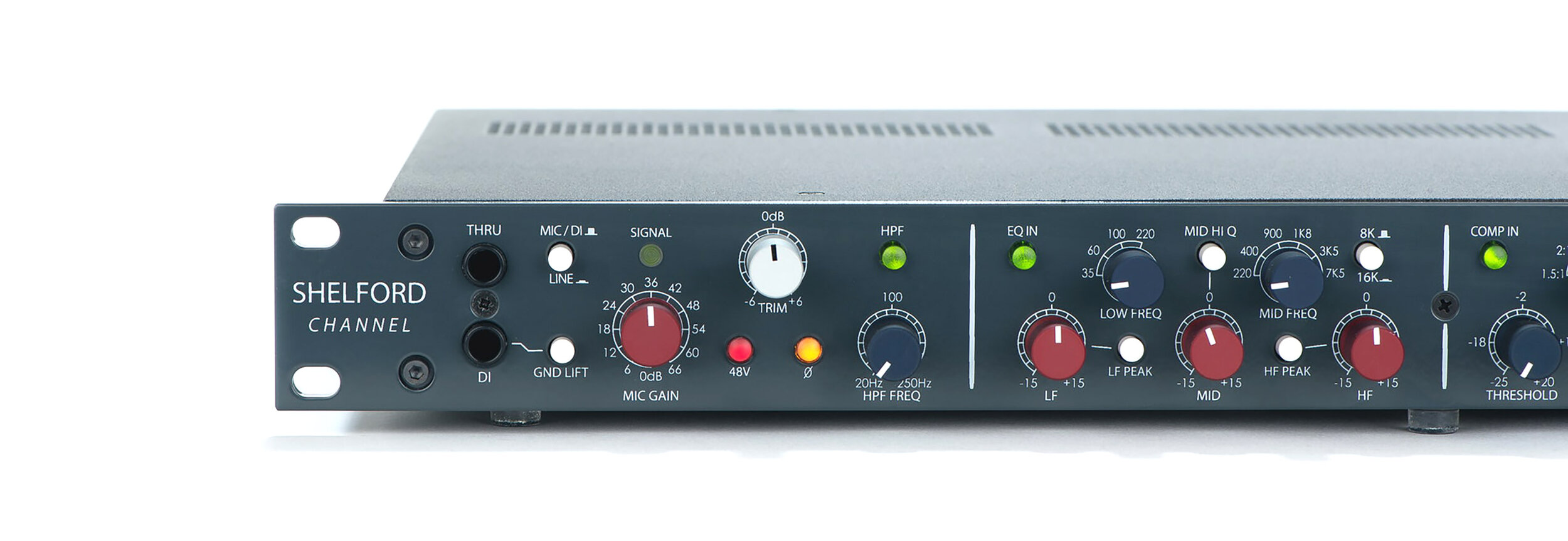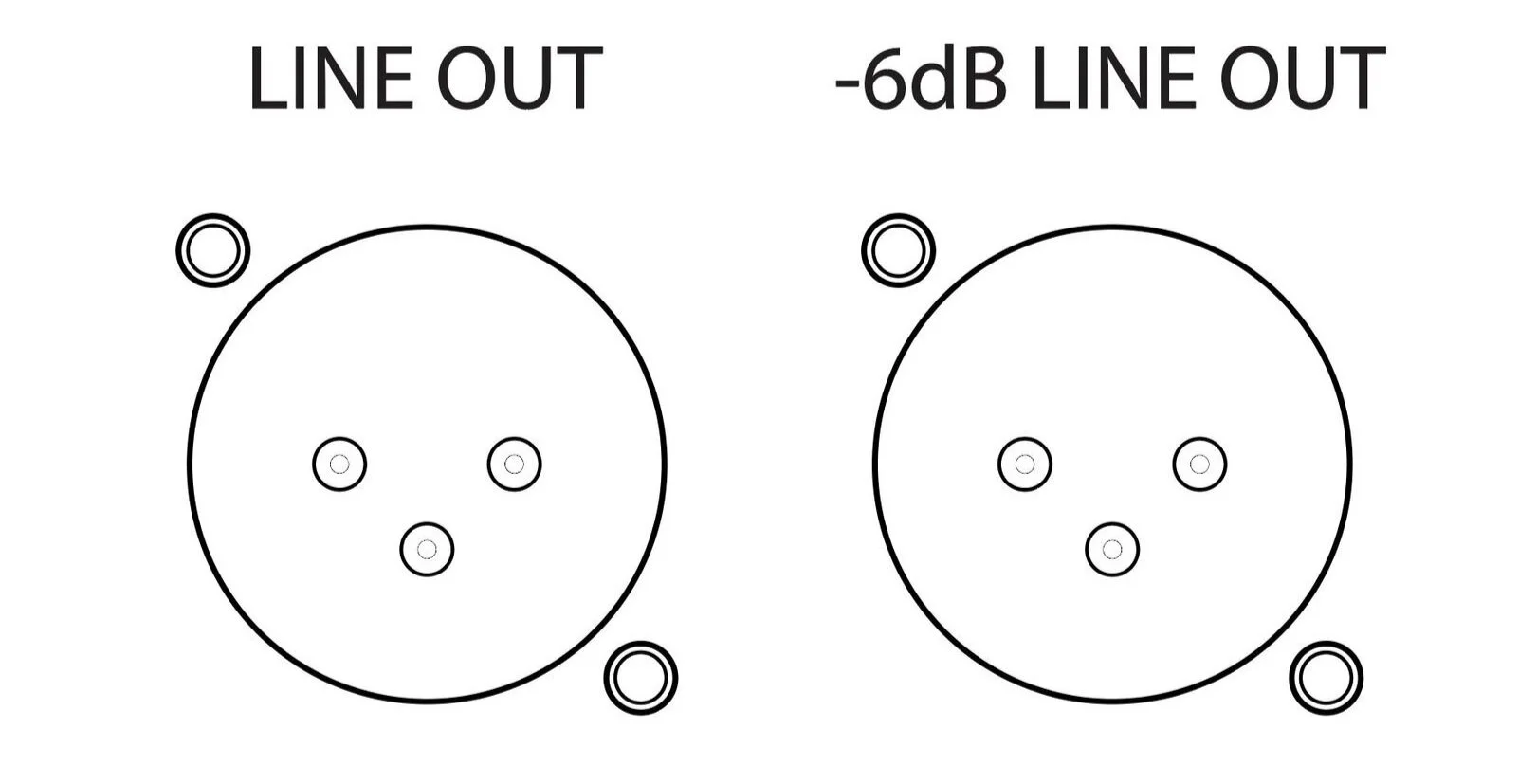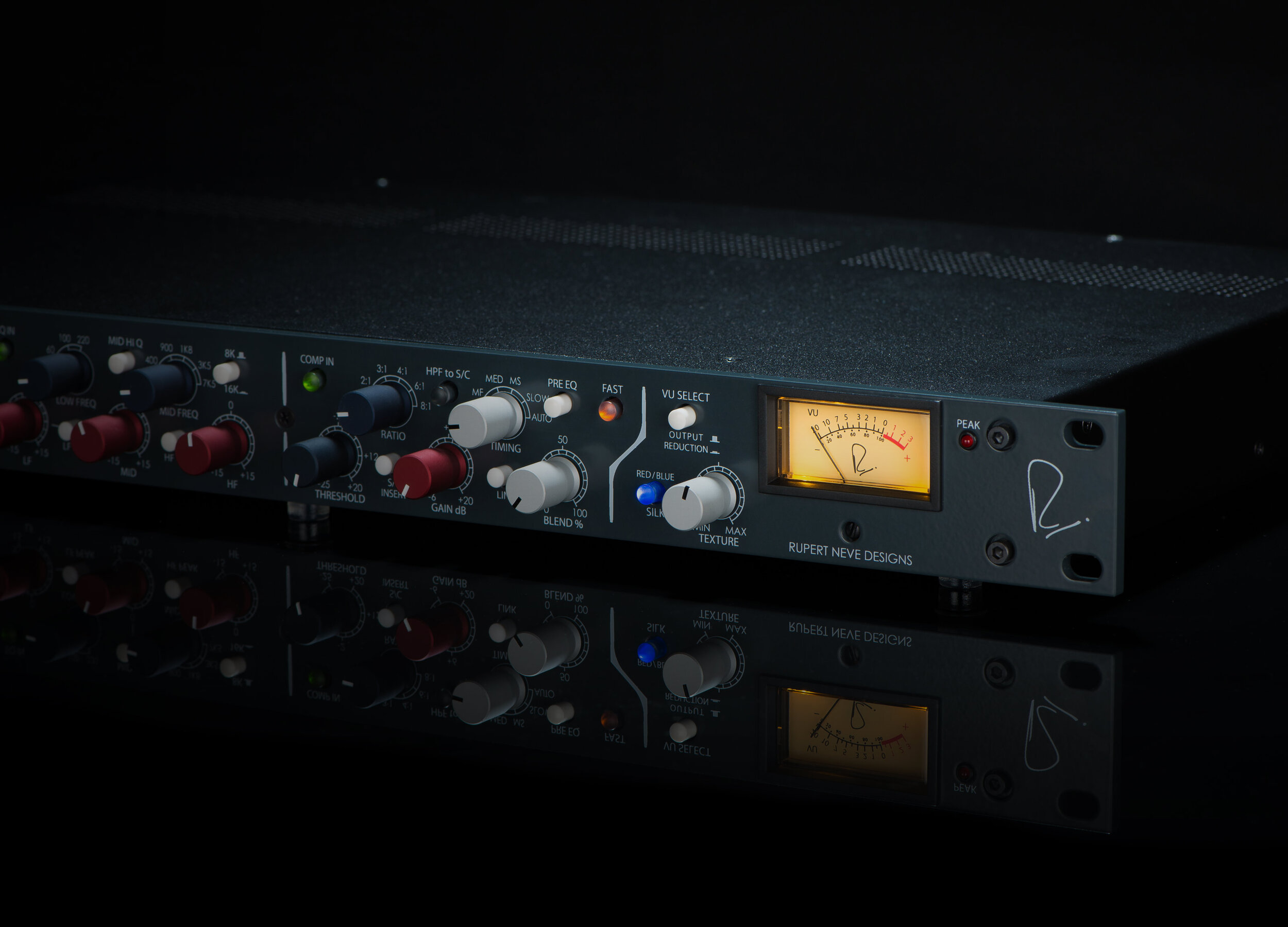
SHELFORD CHANNEL
Mic Pre + Inductor EQ + Compressor
OVERVIEW / MEDIA / FEATURES / REVIEWS / SPECS & RESOURCESA Whole New Vintage.
The Shelford Channel is built around Rupert Neve’s first new transformer-gain, class-A microphone preamplifier in over 40 years, a “best-of-the-classics” inductor EQ section, a tone-packed diode bridge compressor, the power of variable Silk saturation, a new custom transformer output stage, and twice the operating voltage of vintage designs.

“It’s like a time machine...you can look back and see what a 1073 actually sounded like when it was new.”
Over fifty years in the making, the Shelford Channel is the definitive evolution of the original technologies in Rupert’s classic console modules like the 1073, 1064 & 2254, thoughtfully advanced and refined for the 21st century studio.
The Input Stage and Transformer Gain Mic Pre
Like Rupert’s designs from his time in Little Shelford , the Shelford Channel’s preamplifier uses a directly-coupled transformer input with gain provided by the custom transformer itself – a first in over 40 years for Rupert Neve. This new custom-designed input transformer, along with its careful integration with the surrounding class-A circuitry, is critical to the Channel’s bold and instantly recognizable character.
Conveniently, the Direct Input uses the same topology as the best-selling RNDI Active Transformer Direct Interface, providing astonishing clarity for high-Z instrument signals, with unparalleled low-frequency response and an incredibly smooth high end.

WHAT IS
Silk?
The Silk & Texture circuit on the Shelford Channel allows you to fine-tune the amount (and type) of harmonic content in the output stage. This means your signal can be adjusted from quite transparent to settings that produce nearly 10x the amount of sonic color as Rupert’s vintage modules – and in two very unique modes. No matter what sound you’re looking for, Silk can help get you there.

When you apply SILK RED, you’re enhancing harmonic content generated by the highs and high mids of your source. This adds a sparkly sheen to the top end, and is often ideal for sources including vocals, snare, strings, pianos, and other acoustic instruments.

With SILK BLUE, you’re enhancing harmonics generated by the lows and low mids of your source. This tends to “beef up” a signal from the bottom up, making it a great choice for drums, bass guitars, heavy electric guitars, male vocals, and synthesizers.
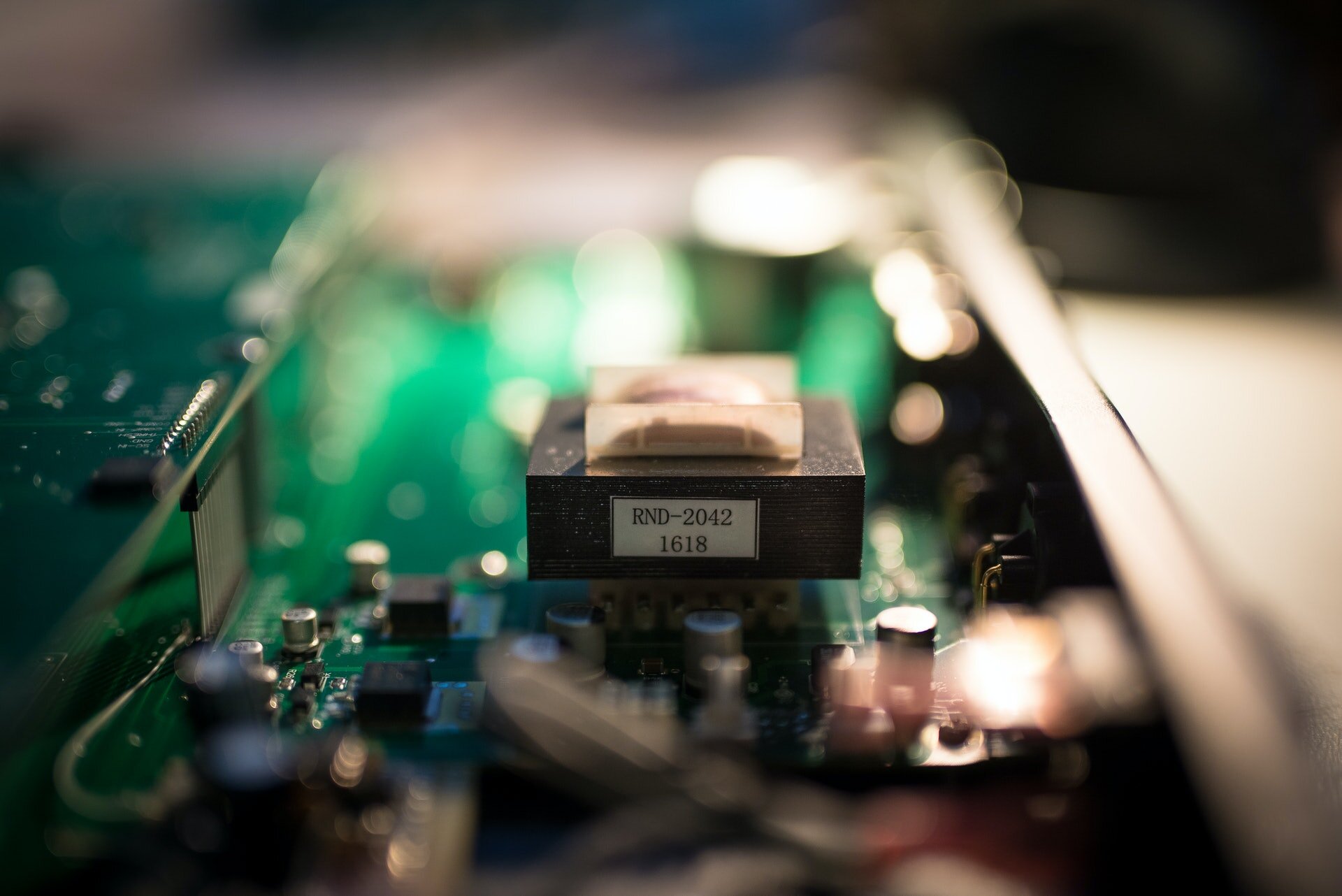
The Custom Transformer Output
The Shelford Channel has a custom transformer output stage with a balanced standard LINE level output. Additionally, a separate -6dBu XLR output can compensate for high levels of input and Silk harmonic saturation, enabling engineers to fully drive the Shelford to achieve more transformer harmonics without clipping the next device in the chain. Both outputs are active and can be used concurrently.
The LINE output is designed capture a more pristine sound at high levels, avoiding non-linear coloration of the output stage and taking full advantage of the Shelford’s higher voltage design. The -6dB out however is optimized to allow an engineer to drive the full voltage range of the Channel – adding dynamic tone with these same non-linear “colorations” – without clipping most professional interfaces. On drums, vocals, guitars and other instruments, this output lets you easily hit the transformer’s “sweet-spot” of non-linear harmonic content, which can bring a recorded performance to life in a way that other effects can’t.
The “Best-Of” EQ
The Shelford Channel’s 3-band, custom-tapped inductor EQ was inspired by our favorite elements of Rupert’s vintage EQ designs. The low frequency band is designed to produce a creamy, resonant bass response similar to a vintage 1064 – but unlike the vintage modules, the LF band on the Shelford Channel can be used as either a shelf or a peak filter, adding punch, dimension, and control to your low end.
The midrange band is based on that of the 1073, ideal for sweetening vocals and instruments while bringing them forward in a mix, and its proportional “Q” response makes it well-suited for minimizing problematic frequencies. The high frequency band is a hybrid vintage / modern design, blending inductor circuitry with capacitor-based topologies to achieve vintage tones with enhanced control, with the shelf / peak corner switchable between 8K or 16K.
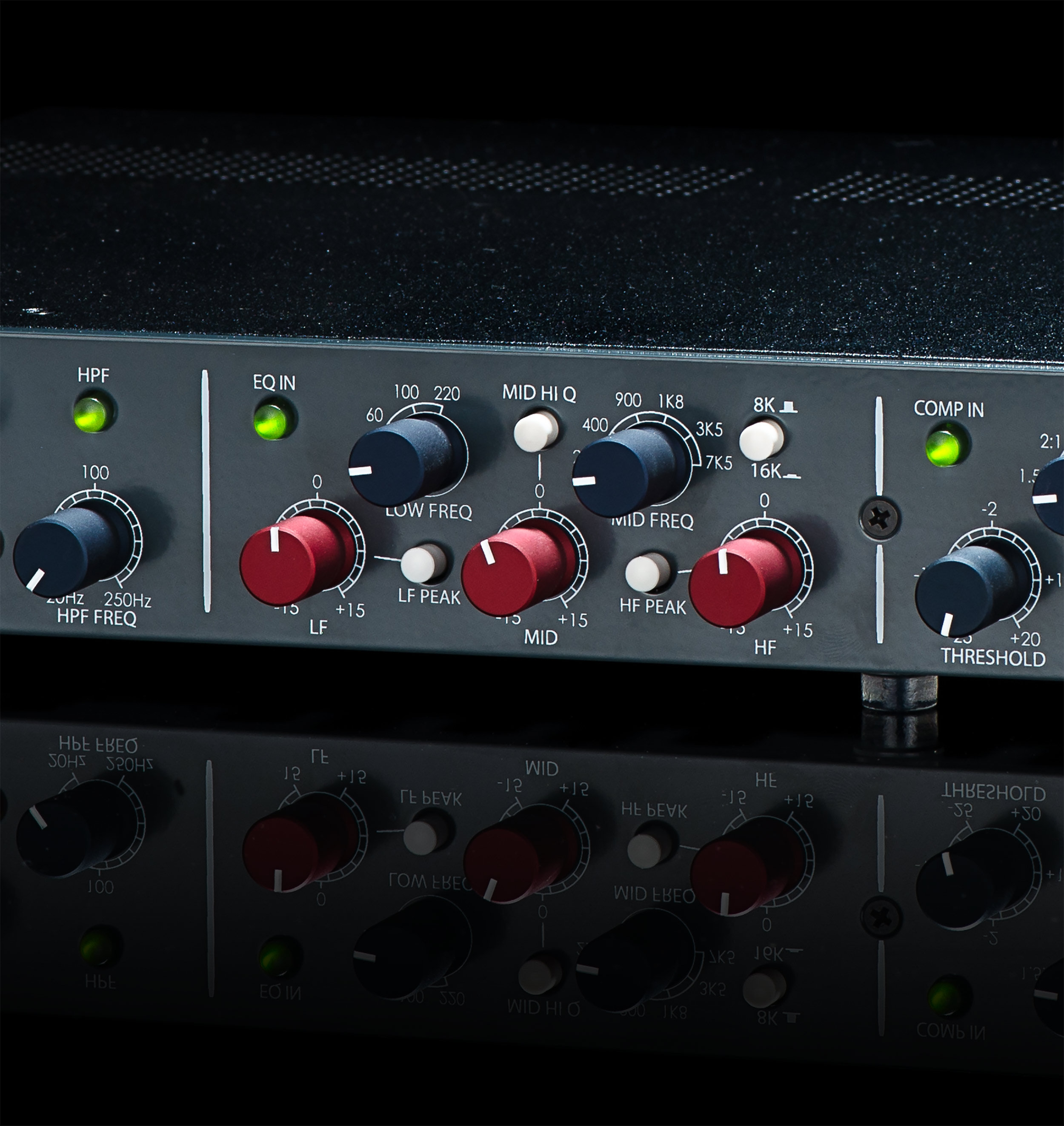
“You're going to need two of these. One will not be enough.”
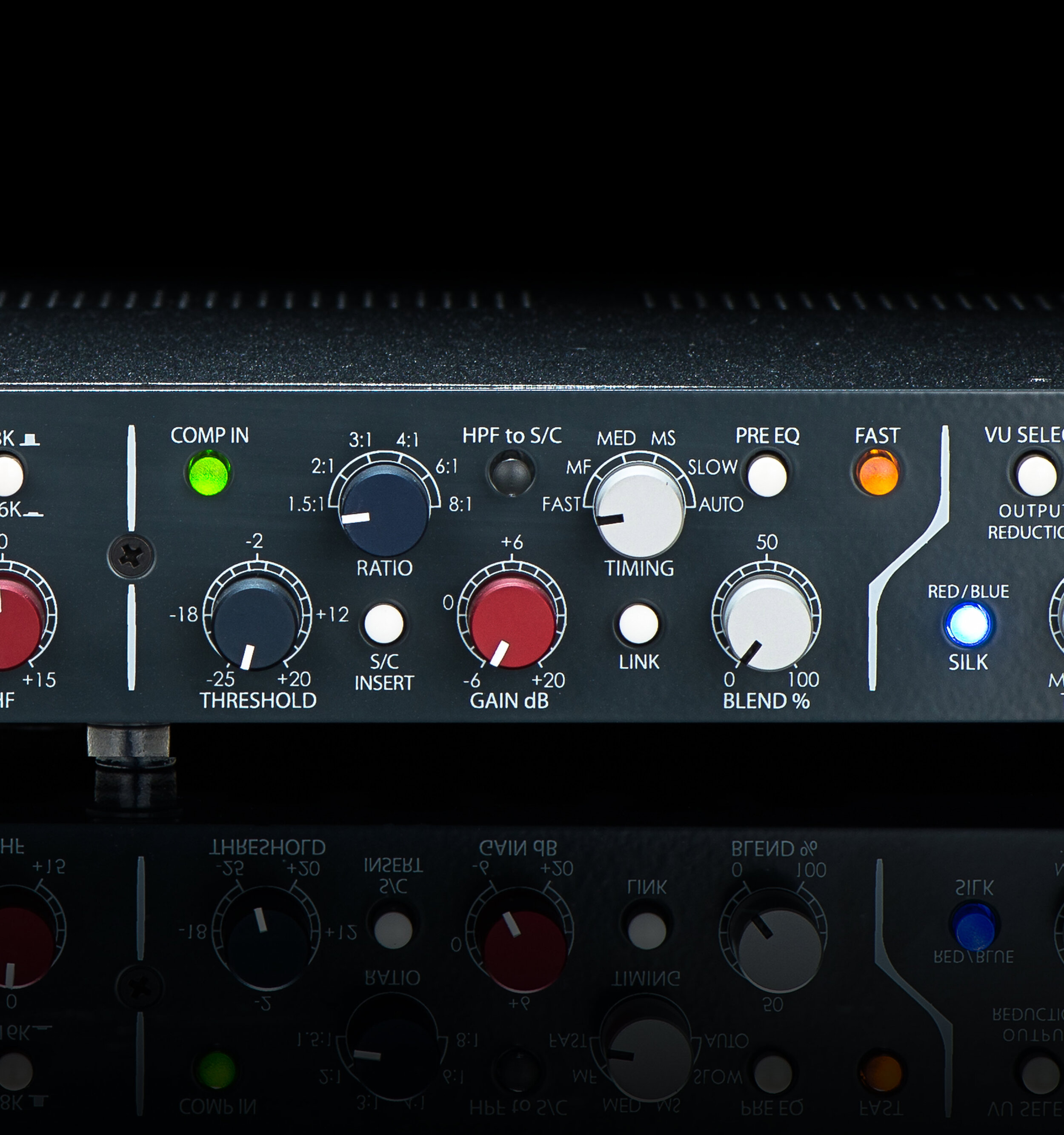
The Diode Bridge Compressor
Like the Inductor EQ and Transformer Gain microphone preamp, the Diode Bridge Compressor in the Shelford Channel is based on the same topologies found in Rupert’s vintage designs – but refined & adapted for the modern engineer.
What is diode bridge compression? Where the VCA compressor found in the Master Buss Processor provides unmatched clarity, the weighty, harmonically rich tonality of diode bridge compression can be essential in pushing key sources like vocals, electric guitars, bass and drums to the forefront of a mix.
By understanding the limitations of vintage units like the legendary 2254, painstaking effort was taken to reproduce the unique tone of these classics while improving the noise floor & accuracy, expanding inflexible time constants, adding full wave sidechain detection for improved dynamic response, and widening the range of threshold and ratio controls.
Delivering the powerful sound of these iconic designs with enhanced flexibility for the modern age, the Shelford’s diode bridge compressor is a dynamic tool equipped to make a statement on virtually any mix or track.
With an infinite variety of tone, the Shelford Channel maintains the soul of Rupert’s vintage designs with new levels of versatility, delivering the combined essence of fifty years of Rupert Neve’s designs.

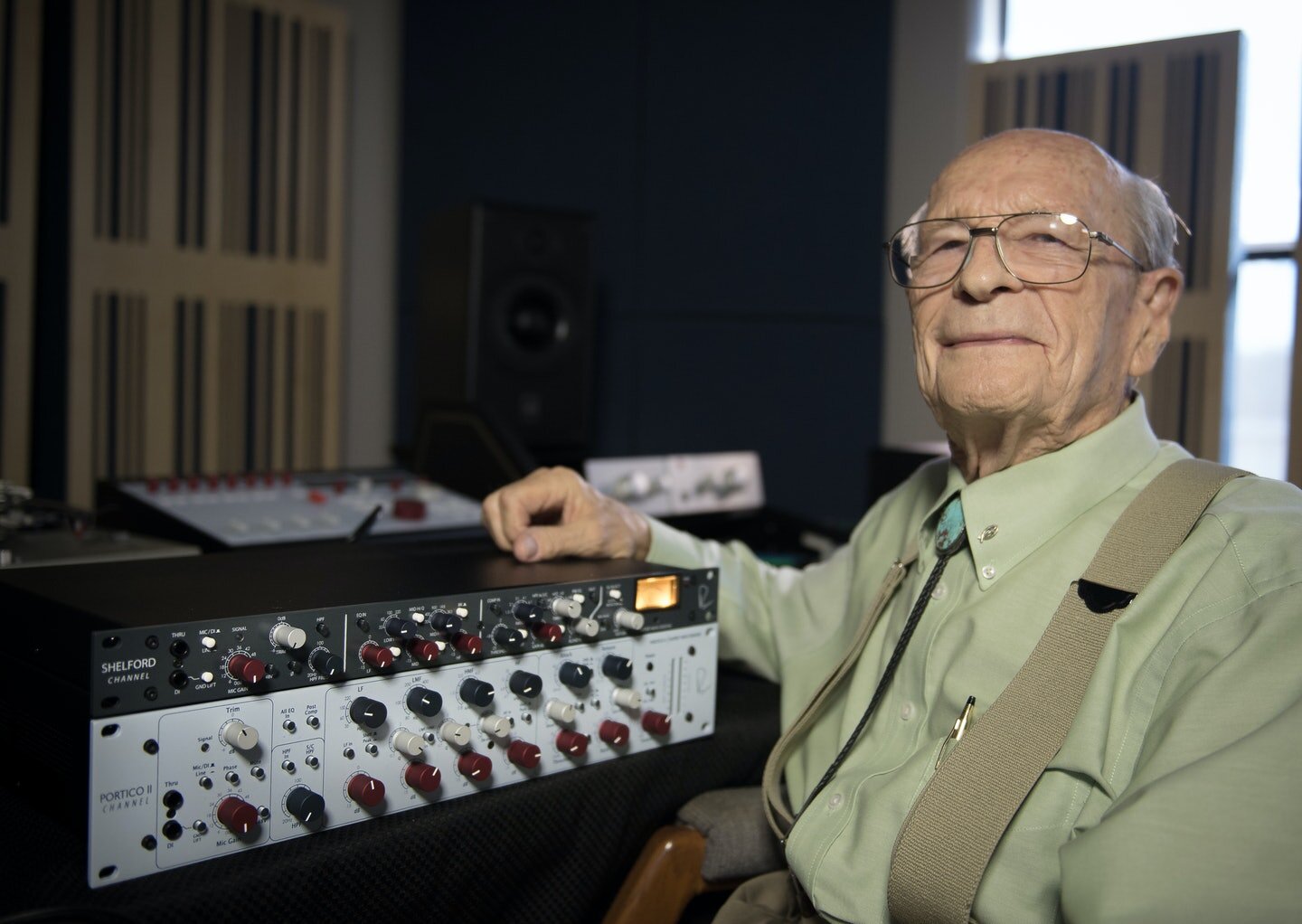
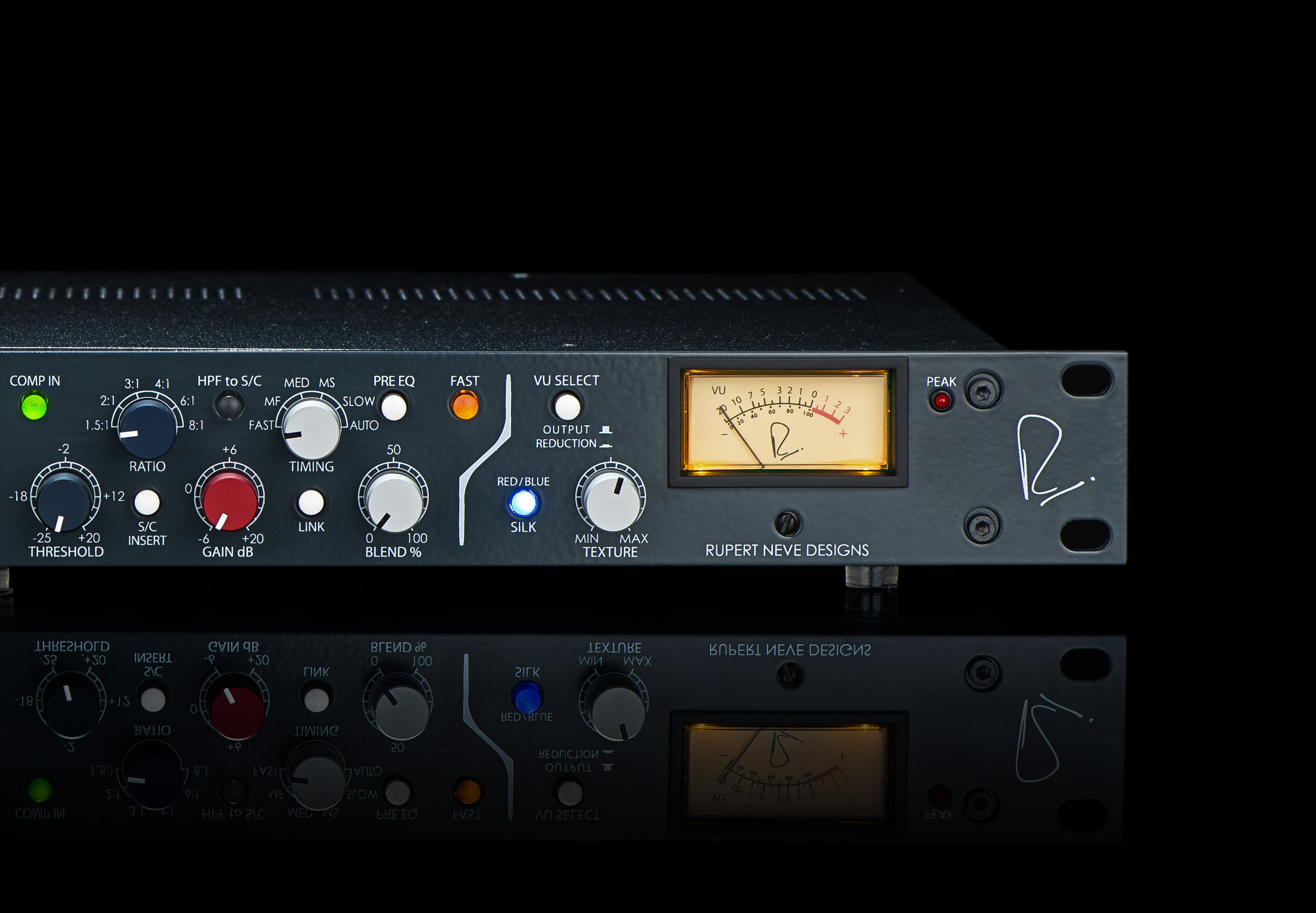

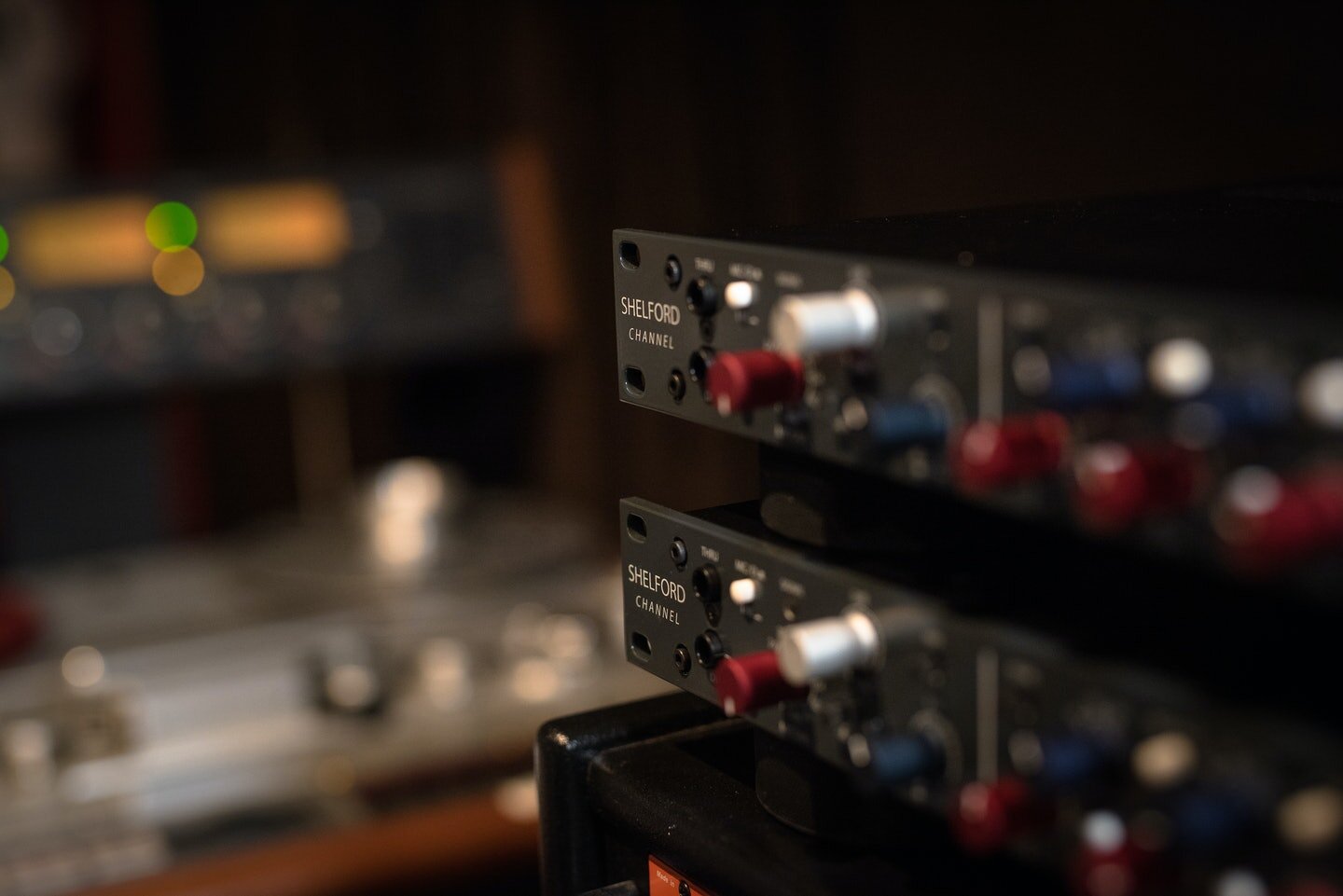
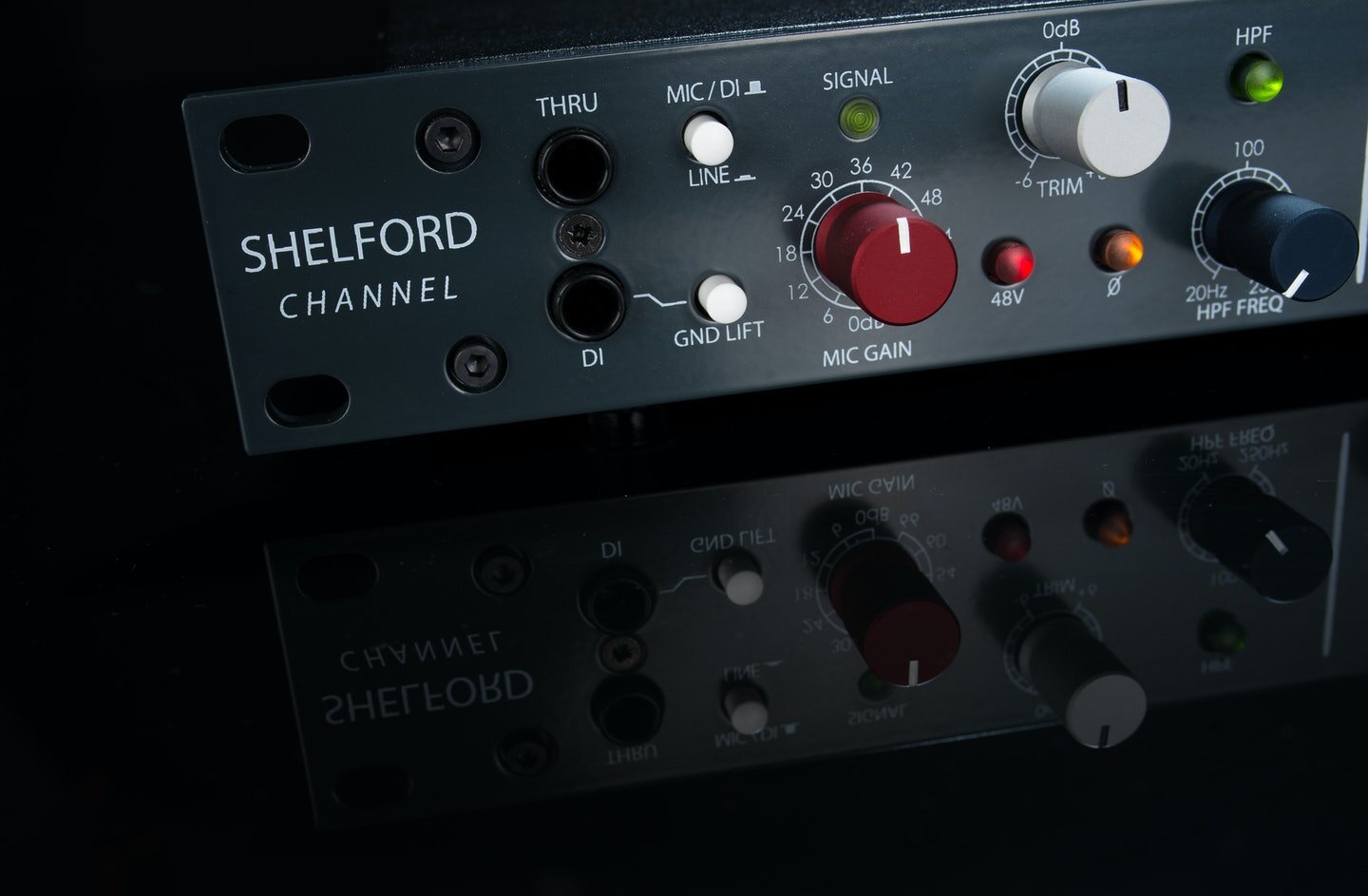

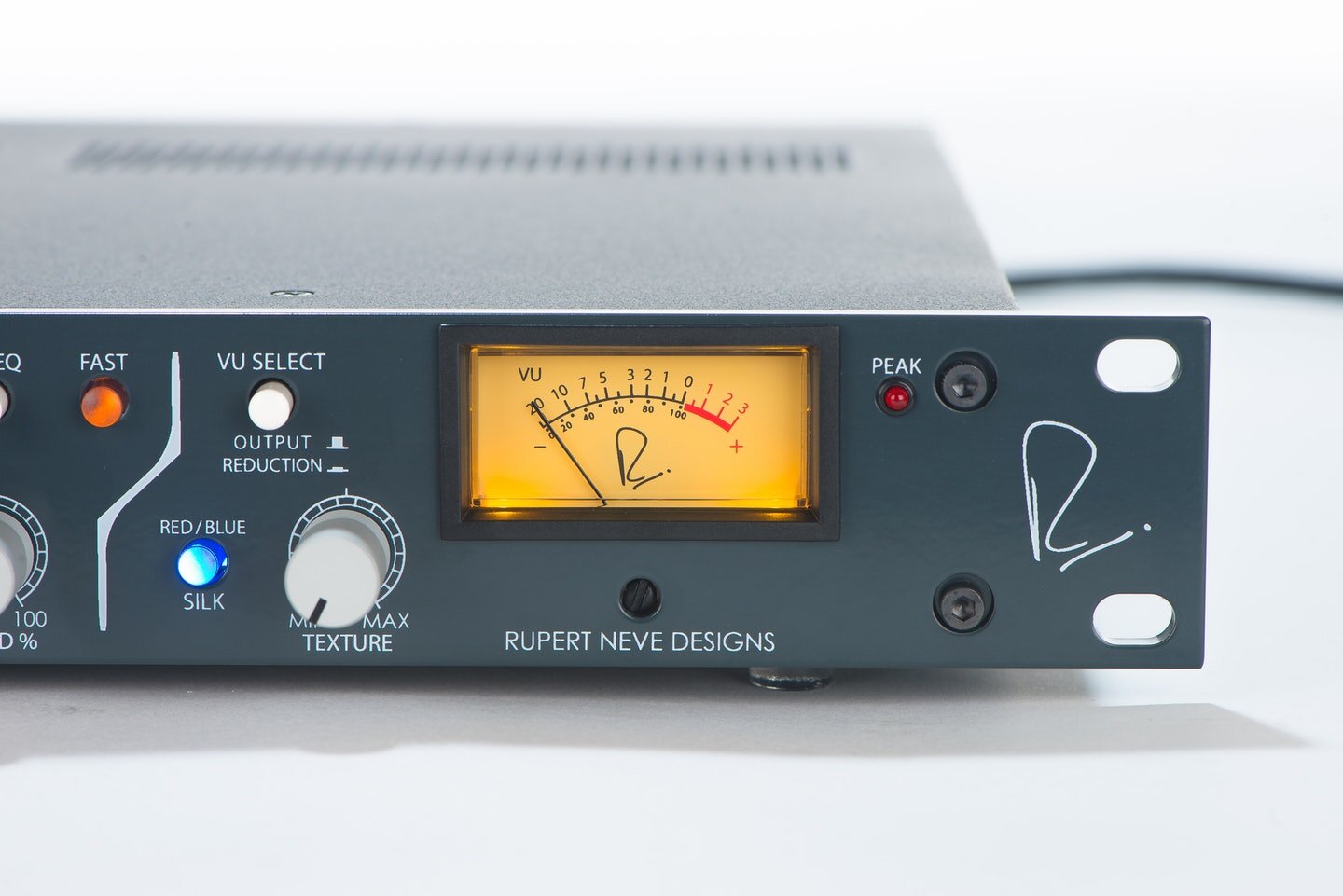
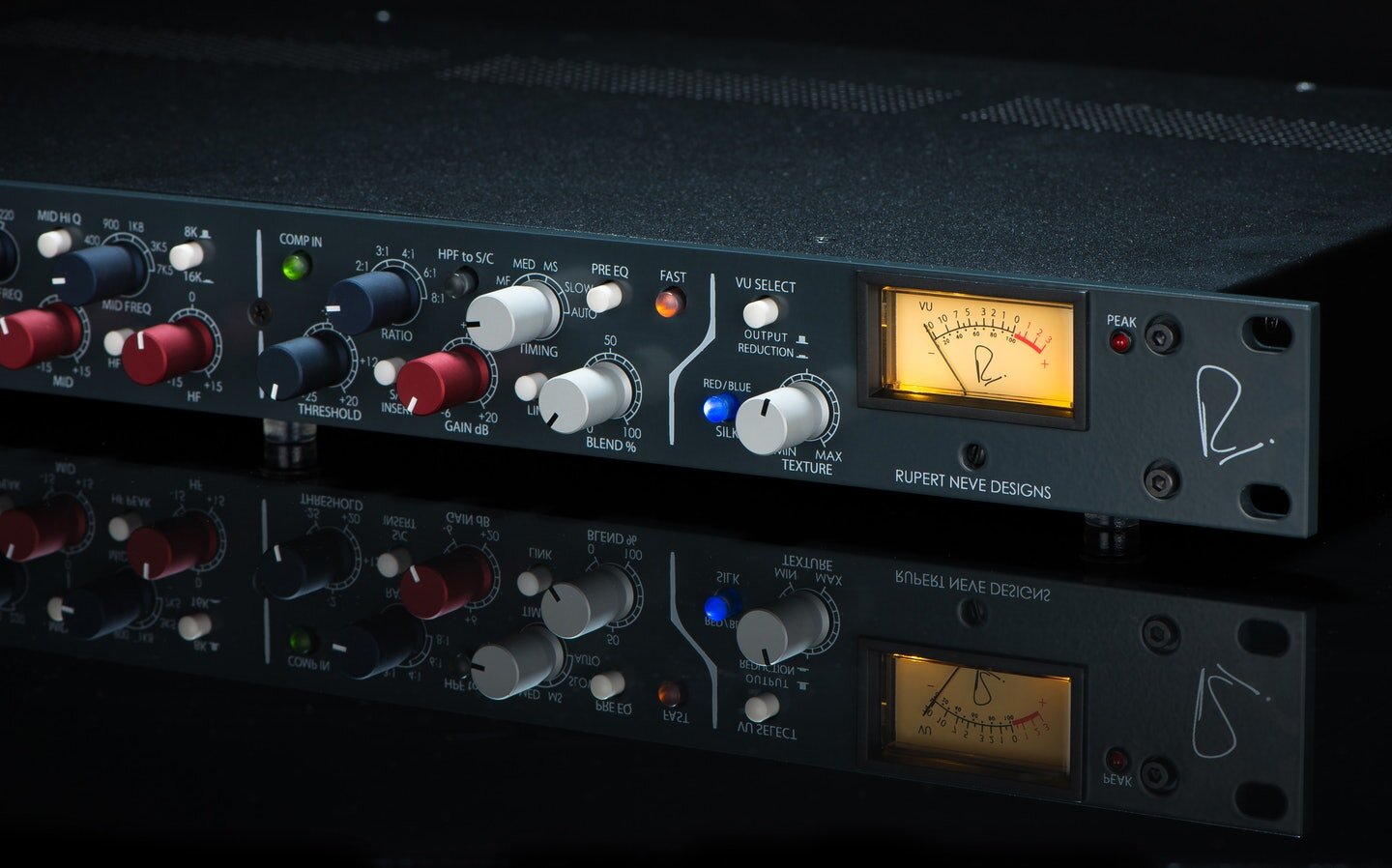

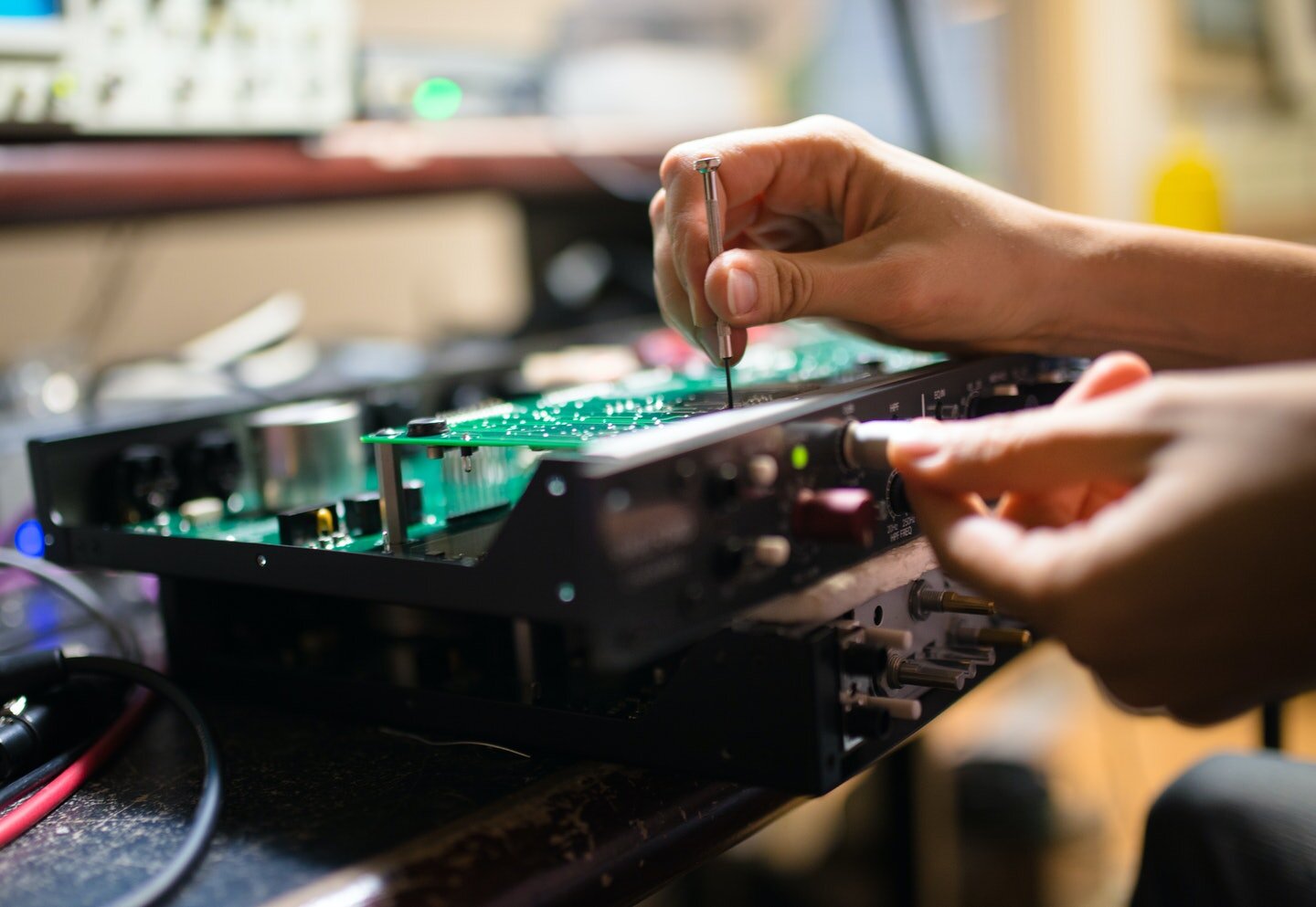
THRU
Passive loop 1/4” output of the DI input signal.
DI
1/4” jack for direct injection (DI) or instrument inputs.
MIC/DI/LINE
Push-button switch that selects the Mic/DI input or line input.
GND LIFT
Push-button switch that separates the DI audio signal ground from chassis ground.
SIGNAL
LED that illuminates GREEN when signal is present and RED when near clip point.
MIC GAIN
12-position rotary switch that controls the microphone preamp gain in 6dB steps.
TRIM
31-detent potentiometer that allows the user to adjust the preamp gain within a range of +/- 6dB.
48V
Push-button switch that illuminates RED when +48V Phantom Power is engaged.
Ø (Polarity)
Push-button switch that illuminates AMBER when engaged and inverts the phase of the input signal.
HPF
Push-button switch that illuminates GREEN when the variable high pass filter is engaged.
FREQ
31-detent potentiometer that allows the user to adjust the cutoff frequency of the variable high pass filter within a range of 20Hz to 250Hz.
EQ IN
Push-button switch that illuminates GREEN when the inductor EQ section is engaged.
LF
31-detent potentiometer that controls the amount of boost or cut for the low frequency band within a range of +/- 15dB.
LOW FREQ
4-position rotary switch that selects the corner (shelf) or center (peak) frequency of the low frequency band.
LF PEAK
Push-button switch that toggles between shelf mode (out) or peak mode (in) of the low frequency band.
MID HI Q
Push-button switch that reduces the Q width of the mid frequency band when pressed in.
MID
31-detent potentiometer that controls the amount of boost or cut for the mid frequency band within a range of +/- 15dB.
MID FREQ
6-position rotary switch that selects the center (peak) frequency of the mid frequency band.
8K/16K
Push-button switch that selects between the two available high frequency shelf/peak frequencies: 8kHz (OUT) and 16kHz (IN).
HF
31-detent potentiometer that controls the amount of boost or cut for the high frequency band within a range of +/- 15dB.
COMP IN
Push-button switch that illuminates GREEN when the diode bridge compressor section is engaged.
THRESHOLD
31-detent potentiometer that controls the compressor threshold range from +20dBu to -25dBu.
RATIO
6-position rotary switch that adjusts the compressor ratio from 1.5:1 to 8:1.
S/C INSERT
Push-button switch that engages the side-chain insert SEND & RETURN jacks on the rear panel for external side-chain processing (ex: EQ).
HPF TO S/C
Push-button switch that illuminates GREEN when the compressor side-chain high pass filter is engaged.
GAIN
31-detent potentiometer that controls the compressor make-up gain within a range of -6dB to +20dB.
TIMING
6-position rotary switch that adjusts the compressor attack and release times. NOTE: Please refer to the Specifications section below for specific attack and release time settings.
LINK
Push-button switch that engages stereo compressor link mode.
PRE EQ
Push-button switch that routes the compressor section ahead of the EQ section when engaged.
FAST
Illuminated push-button switch that speeds up all compressor time constants by 30%.
BLEND %
31-detent potentiometer that controls the wet/dry mix of the compressed signal (wet) to the input signal (dry).
VU SELECT
Push-button switch that toggles between metering the compressor output level (OUTPUT) and gain reduction REDUCTION).
SILK IN
Illuminated push-button switch that toggles through the three available SILK modes: OFF, RED, and BLUE. RED enhances harmonic content in high mid and high frequencies. BLUE enhances harmonic content in low and low mid frequencies.
TEXTURE
31-detent potentiometer that controls the amount of SILK harmonics added within the transformer output stage when SILK is engaged.
PEAK
PEAK LED warns when signal levels are peaking 3dB below clip point.
POWER
IEC AC power inlet with integrated power switch. 100-240VAC at 50/60Hz. 35 Watts maximum AC power con- sumption.
GROUND LIFT
Slide switch that lifts XLR Pin 1 from chassis ground on the MAIN OUT and the -6dB OUT to help isolate from ground interference.
LINE OUT
Balanced XLR output utilizing a custom Rupert Neve Designs transformer.
-6dB OUT
Balanced XLR output utilizing a lower level, secondary output on the custom Rupert Neve Designs transformer.
SIDE CHAIN SEND
Compressor side-chain insert SEND 1/4” TS jack for connecting to the input of an external processor (ex: EQ).
SIDE CHAIN RETURN
Compressor side-chain insert RETURN 1/4” TS jack for connecting to the output of an external processor (ex: EQ).
LINK
1/4” TS jacks that allow for two Shelford Channel compressors to be linked together for stereo compressor operation. ONLY INTENDED FOR USE WITH OTHER SHELFORD CHANNEL LINK JACKS.
LINE IN
Balanced XLR input that can be utilized for LINE level signals.
MIC IN
Balanced XLR input that can be utilized for MIC level signals.
REVIEWS
“I love it, it’s fantastic, and it’s saved my bacon on many occasions.”
Mark ‘Spike’ Stent
Beyoncé, Lady Gaga, Coldplay, Muse
“…just pure glorious sound.”
Tony Visconti
David Bowie, T. Rex
“The 1073 vocal sounded really good, but dare I say, I preferred the sound of the Shelford over the vintage module? Heresy!!! That’s when Sam and I exchanged looks that said, ‘Damn, that thing is killer!’”
Geoff Stanfield / Tape Op Magazine
“I’ve always felt that I had to choose between precision and color when deciding which channel strip to go with for a particular task. The Shelfords remove that from the equation as they strike the perfect balance between a crisp, defined sound and colorful, warm tones while still allowing me to tip the balance far in either direction…I had previously used several different compressors, pres and EQs from different channels to achieve the sounds I was looking for, but for the first time I’ve been getting finished-sounding tones from a single unit.”
“From pre to silk, every component in the Shelford Channel shines on its own – but when combined in this way, you really have something special. With the Shelfords you’re seeing the sum total of Rupert Neve’s sonic legacy distilled into a single piece, and as an artist it’s truly inspiring.”
Scott Hansen, a.k.a. Tycho
“I am blown away by the Shelford Channel. Everything about it is amazing, and it is clear that no detail was overlooked. Whether it’s my bass, my drum mics, or a vocal, it is one of those pieces of gear that will get used on a daily basis and stand the test of time.”
Adam Blackstone
Drake, Jay-Z, Nicki Minaj, Eminem, Rihanna
“The Shelford Channel is a master class in ‘best-of-class’ design and is an absolute must for any engineer looking to add to their armoury of sounds.”
Drew Robertson / Professional Sound Magazine
“It sounds like the best aspects of the 1073 and 1066’s. It sounds so familiar and comforting, and the compressor is mind blowing. You can move in fine brush strokes, but it can also be a bulldozer.”
Craig Ross
Patty Griffin, Spoon
“I compared the Shelford Channel to a classic 1066 running into a 2254 compressor and I loved the flexibility of the new design. Well done!”
Joe Baldridge
Keith Urban, Kelly Clarkson
“It’s like a time machine…you can go back and hear what a 1073 actually sounded like when it was new…after working on a vintage Neve console for 10 years, it’s exciting to hear the Shelford sound like a 1073 and 2254 are supposed to, but without all the baggage.”
Mitch Dane
Jars of Clay
“I love how easy it is to achieve your desired sound. The difference it makes as you move parameters is always smooth but reactive. I’ve tried other units that are either too subtle or too reactive and it’s been a battle to find the perfect result. The Shelford doesn’t require thinking! You don’t necessarily hear it doing the work (which is good) but you know it’s doing it.”
Jonnie Williams, FOH
Thundercat
“This piece to me just sounds classic. ”
Matt Ross-Spang
Jason Isbell, Margo Price
“I’m pi**ed that it took so long to put all of this into one box. This is ALL the best stuff.”
F. Reid Shippen
Kenny Chesney, Dierks Bentley
“You’re going to need two of these. One will not be enough.”
Vance Powell
Jack White, Chris Stapleton

SPECIFICATIONS & DOWNLOADS
MIC PREAMP
INPUT IMPEDANCE
2200 Ohm
MAXIMUM INPUT LEVEL
+21.5 dBu from 150Hz to 22kHz
+8 dBu 20Hz to 22kHz
NOISE
Un-weighted, 22Hz - 22kHz, source impedance 150 Ohm balanced.
Line Out (Unity Gain) -100.9 dBu
-6dB Out (Unity Gain -106.6 dBu
Line Out (+30dB Gain) -91.37 dBu
Line Out (+66dB Gain) -64.1 dBu
Equivalent Input Noise -121.37 dBu
FREQUENCY RESPONSE
17Hz to 45kHz: +/-0.25 dB
DIRECT INPUT
MAXIMUM INPUT LEVEL
+8 dBu from 20 Hz to 120 kHz
NOISE (LINE OUT)
-100 dBu (22Hz to 22kHz)
LINE INPUT
MAXIMUM INPUT LEVEL
+30.5 dBu from 20Hz to 30kHz
TOTAL HARMONIC DISTORTION AND NOISE
@ 1 kHz, +20 dBu output level, no load: Better than 0.002%
@ 20 Hz, +20 dBu output level, no load: 0.05% Typical (2nd and 3rd harmonic)
NOISE (MAIN OUTPUT)
Un-weighted, 22Hz - 22kHz, source impedance 40 Ohm balanced, no load.
-101.1 dBu
FREQUENCY RESPONSE
<10 Hz to 110 kHz: +/- 0.25 dB
120 kHz: +/- 0.32 dB
MAXIMUM OUTPUT LEVEL
16Hz to 20kHz: +26 dBu
TOTAL HARMONIC DISTORTION AND NOISE WITH SILK ENGAGED
SILK RED
MIN TEXTURE @ 100 Hz, +20 dBu input level, no load: 0.0131%, mostly 3rd harmonic (typical)
MAX TEXTURE @ 100 Hz, +20 dBu input level, no load: 1.66%, mostly 2rd harmonic (typical)
SILK BLUE
MIN TEXTURE @ 100Hz, +20 dBu input level, no load: 0.0079%, mostly 3rd harmonic (typical)
MAX TEXTURE @ 100Hz, +20 dBu input level, no load: 0.941%, mostly 2rd harmonic (typical)
HIGH PASS FILTER
Continuously variable swept frequency from 20 Hz to 250 Hz.
Slope: 12 dB/Octave
EQ NOISE
Un-weighted, 22 Hz-22 kHz: -92 dBu
SIGNAL PRESENT
Illuminates GREEN when input stage signal level reaches -20 dBu
OVERLOAD INDICATOR
Illuminates RED when input stage signal level reaches -23 dBu
DIODE BRIDGE COMPRESSOR SECTION
COMPRESSOR NOISE (BW 22 Hz – 22 kHz)
0dB Makeup Gain: -84.5 dBu
+20dB Makeup Gain: -64.2 dBu
TIME CONSTANTS
Note: Time Constant (TC) measurements taken represent full range achievable between 1.5:1 and 8:1 ratio set- ting, 0 dBu I/P 1kHz burst tone used for all recorded measurements
Fast (TC1): Attack 180µS — 1.8mS // Release 100mS – 150mS
Medium Fast (TC2): Attack 750µS – 5.25mS // Release 160mS – 250mS
Medium (TC3): Attack 2.7mS – 18mS // Release 350mS – 525mS
Medium Slow (TC4): Attack 4.6mS – 38mS // Release 600mS – 1 S
Slow (TC5): Attack 11mS – 72.5mS // Release 800mS – 1.25 S
Auto (TC6): Attack 5.75mS – 35.5mS // Dual Release: T1 500mS, T2 1S
’FAST’ Mode: Speeds up all compressor time constants by 30%
PRODUCT DIMENSIONS
19” (48.3 cm) x 10.5” (26.7 cm) x 1.75” (4.5 cm)
SHIPPING DIMENSIONS
24” (61 cm) x 13” (33 cm) x 4” (10.2 cm)
SHIPPING WEIGHT
12.25 lbs. (5.5 kg)
FREQUENTLY ASKED QUESTIONS
The Shelford Channel uses a more vintage-style direct-coupled transformer with gain for the mic preamplifier, which has a different impedance characteristic as compared to the electronically balanced inputs of our other mic preamps.
Of importance: while what most people think of as “vintage Rupert Neve preamp tone” is almost entirely derived from the output stage transformer (and is controllable in the Shelford Channel and other modules via Silk / Texture), the direct-coupled input transformer with gain topology does have a somewhat more “mid-focused” quality due to the impedance characteristics in the HF band and saturation effects in the LF band.
Yes! They are isolated from one another and can be used simultaneously.
If you are looking to fully drive the output transformer to impart the non-linear harmonic content that adds dynamic richness to the sound (and you don’t want to clip your converters) the -6dB output is the way to go. If you want maximum headroom, use the main output.
Absolutely - both the EQ and the compressor (and of course the Silk circuit) sound excellent on stereo sources.
While the Shelford Channel’s compressor is not as surgical or precise as the Master Buss Processor, it can be used to great effect on stereo mixes if you have a pair of units. If the diode bridge compressor’s color is too much for the source, you can always dial down the blend control. Lower ratios and slower time constant choices will also impart less color.
To link the compression on two Shelford Channels, simply connect a single 1/4” cable between either of the two link jacks on each unit, press the LINK switch on each unit, and set all front panel settings the same on each unit so each side triggers equally.
Note: Keep in mind that some sources may actually sound better with the compressors unlinked, (i.e. using them in dual mono, not stereo linked). Listen for changes in the stereo imaging and apparent width with linked vs. unlinked units, and make your decision based on that.
The EQ and Compressors in the Shelford Channel are essentially the same as the 551 Inductor EQ and 535 Diode Bridge Compressor. However, the Shelford Channel’s line amp circuitry is based around higher voltages, and the audio transformers don’t have the same size restrictions (and may therefore have slightly better performance).
While the DI is a very similar design to the RNDI, it uses the “input transformer with gain” to feed the mic pre instead of the RNDI’s output transformer, which leads to slightly different performance.
Yes, this is normal. When the frequency positions are changed, the switch momentarily breaks the connection in the audio path, which can cause a click. (Note: how much of a click or pop you hear may also be dependent on the source material, as well as the amount of boosting you’re doing with the control). On the LF band, you may also hear a slight mechanical click from inside the unit itself. That’s the sound of relays switching to change the frequency selection.




